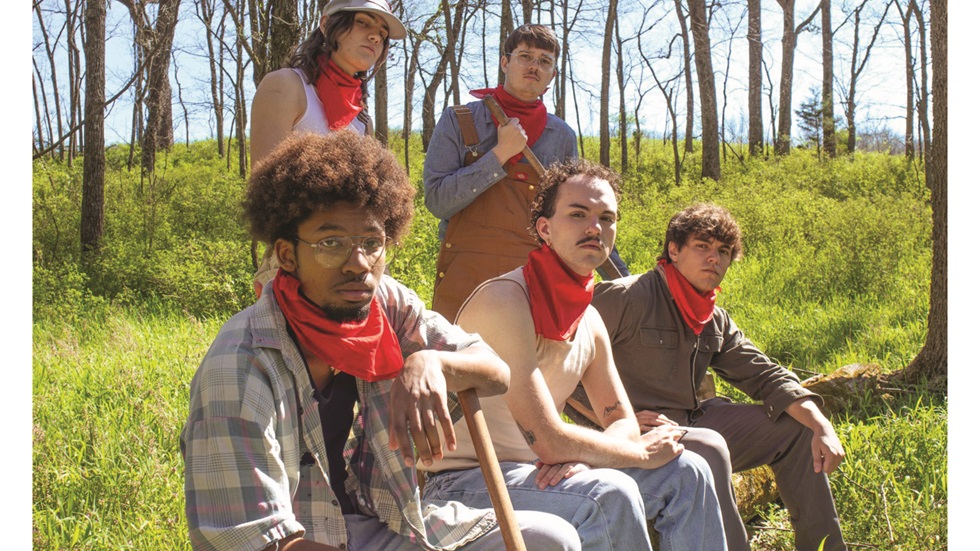
An earlier version of this article originally appeared in Sartorial, a student-run magazine for all things fashion, beauty, and culture published at the Missouri State University. Text by Bryesen Cooper. Photographs by Braeden Cooper. Models: Bryesen Cooper, Mckinley Brown, Jack Spano, Hadley Berry, and Seamus Flanagan. Special thanks to The Hill Family Farm and Teamsters Local 245.
When you hear the word “redneck” what do you imagine? What does redneck mean to you? If you ask most people, they may go on about sunburnt farmers or rural, working-class white people. However, contrary to both, historians and everyday West Virginians tell a much more radical story about where the “red” in redneck comes from. 
It was a warm August day in West Virginia when, in 1921, 10,000 coal miners walked out on strike in protest of terrible working conditions, abysmal housing, poverty wages, and many other issues that working people faced back then, and in their workplaces today. These workers found that the solution to their problems was not to quit and find another job (if another opportunity was to even come) or to stick around and complain every day, but instead to stand together and organize a union.
These miners were organized under the United Mine Workers of America, affiliated today with the AFL-CIO. They decided one of the best ways to bridge the divide between the various cultures and identities of the diverse mine workers was to wear a color they all identified with. The color red is internationally known as the color of workers, and it was wrapped around their necks as a bandana, becoming West Virginia’s “Rednecks.”
As Wilma Lee Steele, a retired art teacher and board member of the West Virginia Mine Wars Museum said in an interview with West Virginia Public Broadcasting:
“All these immigrants from all these different countries, they didn’t speak the same language. They did not have the same culture. And they were fighting each other and divided. But when they tied on these bandanas and marched, they became a brotherhood. And one of the things I love about this union is that it was one of the early ones that said equal pay for Blacks and whites. It’s pretty special.”
Sadly for the conscious miners, the coming days became dangerous, as they faced violent opposition from the wealthy mine owners. As these men stood up for themselves, the big businessmen who owned the mines paid anyone willing to fight striking workers.
As Abby Lee Hood wrote in Smithsonian Magazine:
“They set out from the small hamlet of Marmet with the goal of advancing…to meet the coal companies on their own turf and demand redress. They would not reach their goal; the marchers instead faced opposition from deputized townspeople and businesspeople who opposed their union organizing, and more importantly, from local and federal law enforcement that brutally shut down the burgeoning movement. The opposing sides clashed near Blair Mountain, a 2,000-foot peak in southwestern Logan County, giving the battle its name.”
Over several days, these miners faced a brutal conflict with company officers, along with government agents on the local and federal levels. This battle, ending with an estimated 16 miners losing their lives against federal agents, displayed great heroism on the part of working people.
Though not many know of the Battle of Blair Mountain and the seemingly forgotten “Mine Wars” of the past, we still see the courage of these miners acted out every day. As the Communications Workers of America (CWA AFL-CIO) puts it: “Wearing RED…is a sign of unity and solidarity. In times of harmony, it is a symbol of remembrance and in hard times, a sign of strength, courage, power, and resolve…that we all stand together in the face of adversity in whatever form it may choose to come.”
Providing a more local perspective, Don Giljum, a professor, retired business manager of the Operating Engineers’ International Union Local 148, and past executive board member of the Greater St. Louis Central Labor Council and Missouri AFL-CIO says:
“In my local union, we always printed our contract books for the members in red. The reason for that was to signify the blood and sacrifice of our members given to secure our collective bargaining agreement. We also wore red for various actions to show solidarity and the willingness to shed blood if necessary to protect and advance our causes.
“The members never really associated red with the Communist or socialist [cause]. In fact, I would say that the majority of our members would reject the idea of being called [a] communist or socialist, even though I would tell them that a labor union was in fact a socialist organization.” 
Even today, red has a strong visual and symbolic meaning. People wear red because they want to stand out. Entire countries that are home to millions or even a billion people raise red flags every morning; union workers in mass march with red banners, logos, shirts, and signs. Red, as it has most popularly been used, has stood for power and resolve, justice over injustice, and above all, unity and solidarity among all working people.
May Day—International Workers Day—started in the United States in 1886, a day born in the struggle for workers’ rights, safety, and the 8-hour workday. On this day, streets around the world will be filled with seas of people wearing red, marching, rallying, and celebrating worker power. So, when you wear or use red, think about its history and the statement you are going to make.
We hope you appreciated this article. At People’s World, we believe news and information should be free and accessible to all, but we need your help. Our journalism is free of corporate influence and paywalls because we are totally reader-supported. Only you, our readers and supporters, make this possible. If you enjoy reading People’s World and the stories we bring you, please support our work by donating or becoming a monthly sustainer today. Thank you!











